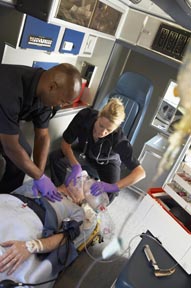Researchers with the Resuscitation Outcomes Consortium, which includes the University of Alabama at Birmingham, report today in the New England Journal of Medicine on the first two large-scale ROC trials. Both trials evaluated new strategies for cardiopulmonary resuscitation following cardiac arrest.
 The investigators report the trials were ended early when it became clear the new strategies being studied did not produce better outcomes than existing standards of care.
The investigators report the trials were ended early when it became clear the new strategies being studied did not produce better outcomes than existing standards of care.
One study examined whether paramedics responding to a cardiac arrest should perform CPR prior to checking cardiac rhythm with a defibrillator. Current practice calls for paramedics to deploy a defibrillator and apply electric shock immediately.
“There was evidence from a European study that CPR performed prior to defibrillation might be beneficial by restarting blood flow before the shock is applied, priming the pump, so to speak,” said Henry Wang, M.D., associate professor and vice chair for research in the UAB Department of Emergency Medicine. “However, our findings showed that there was no difference with prior CPR. Thus, EMS crews and other first responders may choose the approach that best suits their needs.”
The other study examined a device known as an impedance-threshold device, a valve attached to the oxygen bag used in rescue breathing. The valve allows air to be exhaled during the chest compression phase of CPR, reducing pressure in the heart. Evidence suggested that reducing the pressure in the heart would help blood flow return to normal as the heart resumed beating.
“The results of this study showed there was no improvement in cardiac-arrest outcomes associated with the use of the impedance-threshold device,” said Wang. “The significance here is that these devices commonly are used by many EMS agencies. Our findings suggest there is little reason to spend money on purchasing these devices, nor to spend time training in their use or employing them in the field.”
Research outcomes that disprove a hypothesis can have great value, the investigators say. They can confirm best-practices and provide a better baseline understanding of the issue at hand.
“We’re always looking for ways to improve the practice of medicine in all its forms,” said Wang. “Sometimes what we think might be a good idea doesn’t pan out. It’s important that we know for sure what works and what does not.”
“One benefit we saw in both trials was that the participating EMS agencies stressed good-quality CPR across the board, and that by itself led to better survival outcomes for cardiac arrest,” said Shannon Stephens, EMTP, a researcher in the Department of Emergency Medicine.
The ROC consists of 11 research centers in the United States and Canada, including UAB’s Alabama Resuscitation Center.
The ROC is funded by the National Heart, Lung, and Blood Institute, Institute of Circulatory and Respiratory Health, United States Army Medical Research and Materiel Command, Defence Research and Development Canada, Heart and Stroke Foundation of Canada, and American Heart Association.